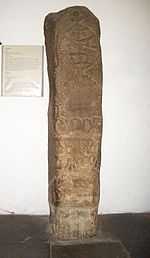Luso Sundanese padrão

The Luso Sundanese padrão is a stone pillar commemorating the Sunda–Portuguese treaty, better known as the Luso-Sundanese Treaty of Sunda Kalapa.
History
Because of the growing Islamic force in Demak and Cirebon, the Hindu king of Sunda, Sri Baduga, Prabu Siliwangi, sought assistance from the Portuguese at Malacca. He sent his son, Crown Prince Prabu Surawisesa, to Malacca in 1512 and again in 1521, in order to invite the Portuguese to sign a peace treaty, to trade in pepper, and to build a fort at his main port of Sunda Kalapa.[1] By 1522 (the same year in which Magellan's global circumnavigation was completed), the Portuguese were ready to form a coalition with the Sunda King in order to gain access to his profitable pepper trade.
The commander of the fortress of Malacca at that time was Jorge de Albuquerque. In 1522, he sent a ship, the São Sebastião under Captain Henrique Leme, to Sunda Kalapa with valuable gifts for the king of Sunda. Two written sources detail the concluding of the treaty: the original Portuguese document of 1522, with the text of the treaty and the signatures of the witnesses; and João de Barros’s report in his book Décadas da Ásia, printed after 1777 or 1778.
According to these sources, the Portuguese were welcomed warmly by the former crown prince, now King Prabu Surawisesa Jayapercosa (or King Surawisesa of Pajundan, also called Ratu Sang Hyang, Portuguese Ratu Samian); Barros called him King Samião. The Portuguese was allowed to build a fortress at the mouth of the Ciliwung River where they could load black pepper to their ships. The King also pledged to give one thousand sacks (more than 20 tons) each year to the Portuguese. The treaty was executed in two copies, one for the king of Sunda, one for the king of Portugal; each was signed on August 21, 1522. The Sundanese king's deputies were the chief mandarin, Padam Tumangu; the mandarins Sangydepaty and Benegar; and the xabandar of the land, named Fabian.
"On the said day", these mandarins and other honorable men, together with Henrique Leme and his entourage, went to the very place where the fortress should be constructed at the mouth of the river, on the "land called Sunda Kalapa". There they erected a memorial stone, called a padrão, in what is now the Tugu sub-district of North Jakarta. It was a custom of the Portuguese to set out a padrão (memorial stone) when they discovered a new land. The padrão, now called the Luso Sundanese padrão, is now kept in the National Museum.
Because of troubles in Goa, Portuguese India, the Portuguese failed to keep their promise to come back the following year to construct the fortress. They did not return to the Java Sea until November, 1526, when they arrived in six ships from Bintan under the command of Francisco de Sá.
The padrão was rediscovered at the junction between Jalan Cengkeh and Jalan Kali Besar Timur in 1918 when the Dutch East Indies government made a reclamation in this area.[2]
Details
The padrão contains agreement an dated August 21, 1522 with the signature of the Portuguese officers.[3] It is 2 meters tall. The padrão has a symbol of a lance and a globe, symbols of the discovery of new land that was used by King Manuel of Portugal. The sign of the cross is a symbol of the Order of Christ as the successor of the Order of the Temple of Jerusalem in area of the Portuguese king’s power. DSPOR is the acronym for Do Senhario D.S.P.O.R. de Portugal; ISFERя àMO Esfera du Mundo or Espera means "regions of the world/hope of the world"; and (4) Sign of the cross as the first line but less clear.
References
- ↑ Zahorka, Herwig (2007). The Sunda Kingdoms of West Java, From Tarumanagara to Pakuan Pajajaran with Royal Center of Bogor, Over 1000 Years of Propsperity and Glory. Cipta Loka Caraka.
- ↑ Lilie Suratminto (2011). Creol Potuguese of the Tugu Village: Colonial Heritage in Jakarta Based on the Historical and Linguistic Review 3(1). International Journal for Historical Studies.
- ↑ Heuken, Adolf (1999). Sumber-sumber Asli Sejarah Jakarta I: Dokumen-dokumen Sejarah Jakarta Sampai dengan Akhir Abad ke-16 (in Indonesian). Cipta Loka Caraka. p. 49.